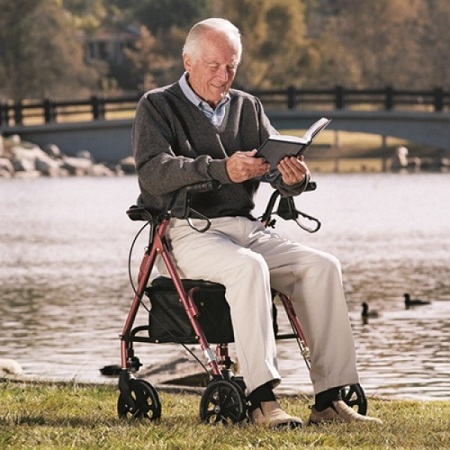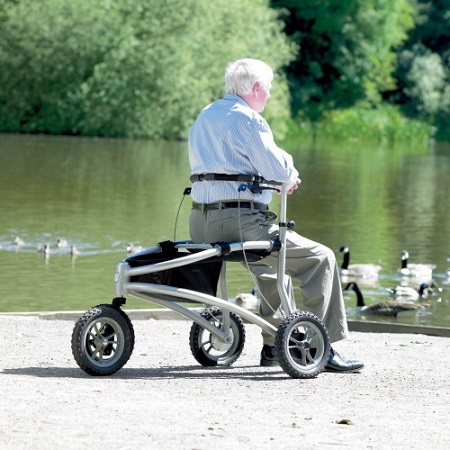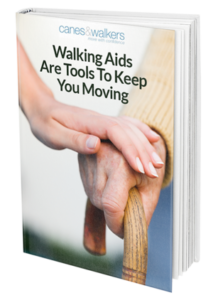Now that you’re older, you may have noticed a decline in how well you’re able to get around. As much as it may pain you to admit it, using a walker or rollator can help you maintain or even increase your mobility.
Here are some safety tips you should keep in mind when you are using your walker or rollator.

Preparing To Stand
Standing up with a walker or rollator is going to be a little different than your used to. To stand, you will want to:
- Make sure the brakes are engaged
- Sit as comfortably on the edge of your seat
- Keep your toes in line with the edge of your seat
- Place both hands on the chair OR one hand on the chair and one hand on the walker.
- Never put all of your weight on the walker, as it could make the walker move
- Lean forward until some of your body weight is on your feet
- Use your legs to stand, your arms should only be lifting the weight your legs cannot.
- Do not move forward until you are certain about your balance
- Unlock brakes and walk.
Walking In New Areas
It’s important to realize that when you are using your walker, you’re going to be walking on terrain that you may not be used to. To walk in new areas, you will want to:

- Proceed slowly until you know the area.
- Watch for anything that could be in the way—children, pets, clothing, area rugs, etc.
- Arrange furniture with enough room for the walker
- Look ahead of where you are walking to anticipate uneven surfaces, hazards, or inclines.
- Never use the walker on an escalator.
Turning Around
If you encounter a situation where you have to turn around, make sure you are within the width of your device. Move the device with you as you turn, keeping your body parallel to the rollator or walker’s front bar. You should never twist your back because you could pull a muscle. Always stay frontward when using the device.
Sitting Down
Sitting down with your walker is going to be a little different than if you’re trying to sit down on your own.
- Stand in front of your seat with the back of your legs almost touching the seat.
- Only sit when you are certain of your balance.
- Slowly move the walker away from you so you can bend forward slightly.
- Engage the locks
- Reach behind you and rest your hands on the arms of the chair.
- Slowly lower yourself in the chair using your legs.

Walking With Your Wheeled Walker
You might think that walking with your walker is like pushing a shopping cart. In some ways, that is true. However, here are some tips:
- Keep your walker in front of you before you start walking. It should be about a foot ahead of you.
- Gently push the walker ahead of you as you walk.
- If your steps aren’t even, shorten the longer step. The shorter step is where balance suffers most.
- When in a kitchen or bathroom, use the counter for support and keep the walker close.
Know Your Limits
Don’t feel like you have to go all over town just because you have a rollator or a walker. It’s important that you understand your limits and your honor them. If you feel like you’re getting tired, stop and sit.
Wear Appropriate Shoes
When you’re going for a walk with your walker, you’re going to want to wear non-slip sneakers or shoes because you can never be too safe. If it is wet, slippery, or icy outside, consider walking indoors instead.
Adjust Your Speed
It’s great that you’re able to get around better, but you want to be mindful of the conditions where you walk. If it’s cold, slipper, icy, or bad weather, you will either want to forego walking outside (as previously mentioned) or alter your speed so that you can safely walk.

Altering your speed is also important when you are walking in public with others. You don’t want to walk too closely to people with your walker or rollator because you don’t want to run into them should they stop abruptly. But, you also don’t want to walk too slowly and take up too much space.
Parking Your Walker
Just like parking your car, you have to be mindful of where you park your walker.
- Park in designated spots—only taking ONE spot. Double parking is a no no!
- In a dining room, ask for a staff member to park the walker to keep paths clear.
- Make sure your walker isn’t blocking traffic.
- When you’re going to open the walker, make sure the unit is locked in place before use.
Keep Your Walker In Proper Working Order
Again, like your car, you will want to perform monthly inspections to ensure your walker remains in proper working order.
- Check the wheels to make sure they are clean and roll easily
- Replace rubber tips of the walker’s legs if necessary
- Consider replacing the tips with a tennis ball or skids so the walker moves easier
- Check the brakes on your rollator
- Do not overload your rollator with bags, as it could topple over
- Do not use the rollator like a wheelchair—it could tip
- If your device is broken, do not use it until it is repaired.

Whether you think it is time to start using a walker, or your family is trying to convince you of using it, it is important that you know how to use the device safely. We hope that this article will give you or your loved ones the confidence to reclaim your mobility and enjoy getting around!



